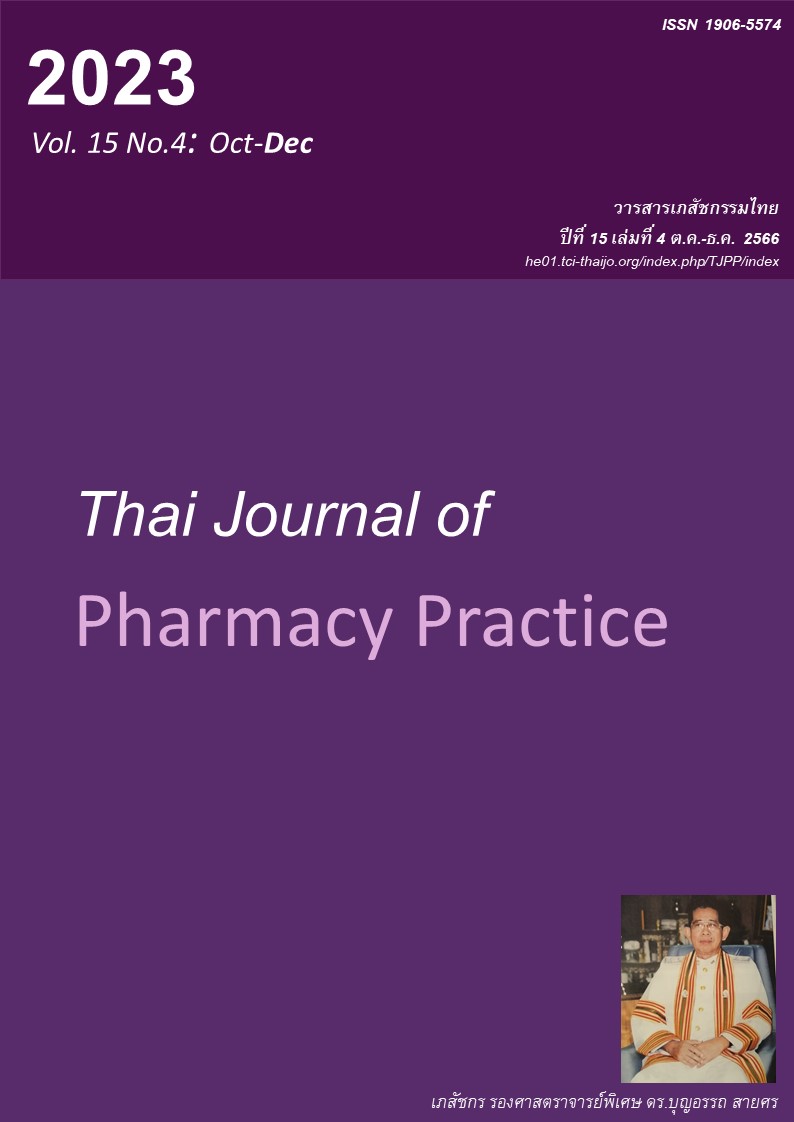ผลของโปรแกรม PESAI (Privacy Computing Ecosystem for AI) และการจัดการโดยสหวิชาชีพ ต่อการชะลอโรคไตเรื้อรังในผู้ป่วยโรคเบาหวานชนิดที่ 2 และโรคความดันโลหิตสูง
Main Article Content
บทคัดย่อ
วัตถุประสงค์: เพื่อศึกษาผลของโปรแกรม PESAI (Privacy Computing Ecosystem for AI) และการจัดการของสหวิชาชีพต่อการชะลอโรคไตเรื้อรังในผู้ป่วยเบาหวานชนิดที่ 2 และผู้ป่วยโรคความดันโลหิตสูง วิธีการ: การศึกษาเป็นวิจัยแบบกึ่งทดลองในตัวอย่างกลุ่มเดียวที่ทดสอบก่อนและหลังให้การแทรกแซง กลุ่มตัวอย่างคือ ผู้ป่วยโรคเบาหวานและโรคความดันโลหิตสูงที่ได้รับการวินิจฉัยจากแพทย์ว่าเป็นโรคไตเรื้อรังระยะที่ 1 ถึง 3 ซึ่งที่มารับบริการที่คลินิกโรคเบาหวานและโรคความดันโลหิตสูง โรงพยาบาลเทพสถิต จังหวัดชัยภูมิ จำนวน 162 คน โปรแกรม PESAI คือ โปรแกรมแจ้งเตือนค่าที่ผิดปกติต่าง ๆ ที่เกี่ยวข้องกับโรคไตเรื้อรัง การศึกษาเก็บข้อมูลก่อนการติดตั้งโปรแกรม 6 เดือนจากฐานข้อมูลอิเล็กทรอนิกส์และเวชระเบียนของโรงพยาบาล ได้แก่ ข้อมูลทั่วไปของผู้ป่วย ระดับความดันโลหิต ผลทางห้องปฏิบัติการ และการใช้ยา การเก็บข้อมูลหลังติดตั้งโปรแกรมทำในวันที่กลุ่มตัวอย่างมารับบริการที่คลินิกโรคเบาหวานและคลินิกโรคความดันโลหิตสูงเป็นระยะเวลา 6 เดือนโดยนัดกลุ่มตัวอย่างมาเจาะเลือด เพื่อหาค่าฮีโมโกลบิน ค่าน้ำตาลเฉลี่ยสะสม แอลดีแอลคอเลสเตอรอล อัตราการกรองของไต โพแทสเซียม ไบคาร์บอเนต และตรวจปัสสาวะ เพื่อหาปริมาณโปรตีนในปัสสาวะ จำนวน 2 ครั้งห่างกัน 3 เดือน หากมีค่าทางห้องปฏิบัติการหรือการใช้ยาที่ผิดปกติจะมีการแจ้งเตือนจากโปรแกรม PESAI และมีการจัดการโดยสหวิชาชีพ ผลการวิจัย: หลังใช้โปรแกรม กลุ่มตัวอย่างมีระดับความดันโลหิต ค่าน้ำตาลเฉลี่ยสะสม และแอลดีแอลคอเลสเตอรอล ลดลงอย่างมีนัยสำคัญทางสถิติ (P<0.05) ในช่วงหลังใช้โปรแกรม จำนวนผู้ป่วยที่ได้รับยา NSAIDs และจำนวนผู้ป่วยที่ไม่ได้รับการปรับยา metformin ลดลงจากก่อนได้รับโปรแกรมอย่างมีนัยสำคัญทางสถิติ (P<0.05) ส่วนค่าอัตราการกรองของไต ฮีโมโกลบิน และจำนวนผู้ป่วยที่มีปริมาณโปรตีนในปัสสาวะเป็นลบ เพิ่มขึ้นจากก่อนได้รับโปรแกรมอย่างมีนัยสำคัญทางสถิติ ( P<0.05) ส่วนค่าไบคาร์บอเนตและและโพแทสเซียมก่อนและหลังใช้โปรแกรมไม่แตกต่างกัน สรุป: การใช้โปรแกรม PESAI ร่วมกับการจัดการโดยสหวิชาชีพอาจช่วยชะลอโรคไตเรื้อรังในผู้ป่วยเบาหวานชนิดที่ 2 และผู้ป่วยโรคความดันโลหิตสูง
Article Details

อนุญาตภายใต้เงื่อนไข Creative Commons Attribution-NonCommercial-NoDerivatives 4.0 International License.
ผลการวิจัยและความคิดเห็นที่ปรากฏในบทความถือเป็นความคิดเห็นและอยู่ในความรับผิดชอบของผู้นิพนธ์ มิใช่ความเห็นหรือความรับผิดชอบของกองบรรณาธิการ หรือคณะเภสัชศาสตร์ มหาวิทยาลัยสงขลานครินทร์ ทั้งนี้ไม่รวมความผิดพลาดอันเกิดจากการพิมพ์ บทความที่ได้รับการเผยแพร่โดยวารสารเภสัชกรรมไทยถือเป็นสิทธิ์ของวารสารฯ
เอกสารอ้างอิง
Centers for Disease Control and Prevention. Chronic kidney disease in the United States [online]. 2021 [cited Oct 6, 2022]. Available from: www.cdc.gov/kid neydisease/publications-resources/ckd-national-fact s.html#:~:text=According%20to%20current%20estimates%3A&text=CKD%20is%20more%20common%20in,%25)%20than%20men%20(12%25).
Wichitsunthornkul K. Epidemiology and review of chronic kidney disease prevention measures [on line]. 2022. [cited Oct 6, 2022]. Available from: thaincd.com/document/file/download/knowledge/ระบาดวิทยา65.pdf.
Chaisang P, Meethong P. Factors predicting chronic kidney disease in community chronic disease patients. Journal of Prapokklao Hospital Clinical Medical Education Center 2018; 35:128-39.
Hospital Pharmacy Association of Thailand. Hand book of care for nephrotic patients for pharmacists. Bangkok: People's Company; 2015.
Klaipaksee A, Asa K. The effects of drug reminder system development in patients with renal impair- ment measured in drug relevant to rational use policy. Thai Journal of Clinical Pharmacy 2020; 26: 19-29.
Aworn N, Ratanadechsakul P, Ratanadechsakul J, Sriudorn P, Phadungsai N, Sommart S. Effect of developed CKD alert pop up ; Case study in Phanom phrai Hospital, Roiet province. Routine development program for national research and R2R network partners; 2014 July 23-25; IMPACT Arena, Exhibition and Convention Center, Muang Thong Thani. Bangkok; 2014. p.156-7.
Saengpeng A, Saramunee K, Anusornsangiam W. Development of dosage adjustment system for in- patients with renal impairment at Prasat hospital, Surin province. Thai Journal of Pharmacy Practice 2017; 9: 280-91.
Klaipaksee A, Ponnok A. Effects of a computerized clinical decision support system on drug use in patients with chronic kidney disease. Thai Journal of Pharmacy Practice 2020; 12: 437-51.
Trisirichoke P, Uttarasat L, Kankan W. Effects of self-management support by multidisciplinary teams to slow chronic kidney disease in primary care units. Khon Kaen Center Hospital. Srinagarind Medical Journal 2019; 34: 552-8.
Chosivasakul K, Piasue N, Sakdanupap S. Program for integrating care by multi- professional teams with
self- management in patients with chronic kidney disease with complex problems. Journal of Thailand Nursing and Midwifery Council 2017; 32: 79-93.
Nuanchuay P. Effect of pharmaceutical care on the control of risk factors for progression of renal function in patients with chronic kidney disease at Thasala Hospital [master thesis]. Songkhla: Prince of Songkla University; 2011.


